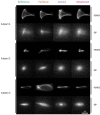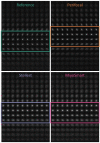Comparison of optical myopia control interventions: effect on peripheral image quality and vision
- PMID: 37497498
- PMCID: PMC10368058
- DOI: 10.1364/BOE.486555
Comparison of optical myopia control interventions: effect on peripheral image quality and vision
Abstract
This study compares the effects on peripheral vision and image quality of four myopia control interventions: a) Perifocal spectacles/ArtOptica, b) Stellest spectacles/Essilor), c) MiyoSmart spectacles/Hoya and d) MiSight contact lenses/CooperVision. Five subjects participated with habitual or no correction as reference. Three techniques were used: 1) Hartmann-Shack sensors for wavefront errors, 2) double-pass imaging system for point-spread-functions (PSF), and 3) peripheral acuity evaluation. The results show that multiple evaluation methods are needed to fully quantify the optical effects of these myopia control interventions. Perifocal was found to make the relative peripheral refraction (RPR) more myopic in all subjects and to interact with the natural optical errors of the eye, hence showing larger variations in the effect on peripheral vision. MiSight had a smaller effect on RPR, but large effect on peripheral vision. Stellest and MiyoSmart also showed small effects on RPR but had broader double-pass PSFs for all participants, indicating reduced retinal contrast. Reduction in peripheral retinal contrast might thereby play a role in slowing myopia progression even when the peripheral refraction does not turn more myopic.
Published by Optica Publishing Group under the terms of the Creative Commons Attribution 4.0 License. Further distribution of this work must maintain attribution to the author(s) and the published article’s title, journal citation, and DOI.
Conflict of interest statement
The authors declare no conflicts of interest.
Figures







References
-
- WHO , “The impact of myopia and high myopia: Global Scientific Meeting on Myopia,” World Health Organization–Brien Holden Vision Institute (2015).
-
- Ogawa A., Tanaka M., “The relationship between refractive errors and retinal detachment–analysis of 1,166 retinal detachment cases,” Jpn J Ophthalmol 32, 310–315 (1988). - PubMed
LinkOut - more resources
Full Text Sources
